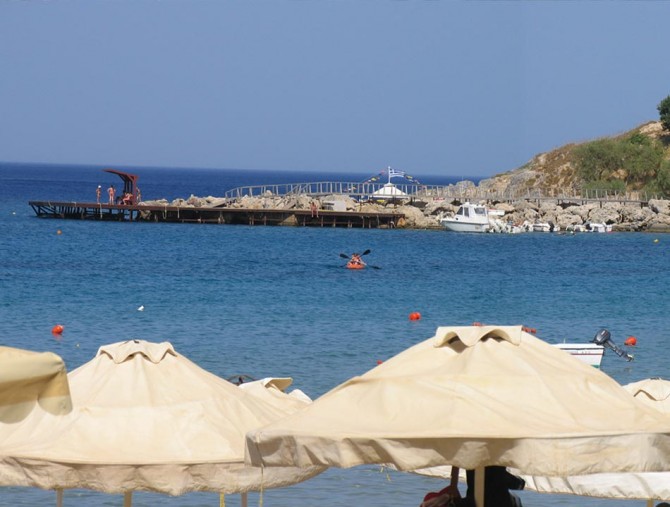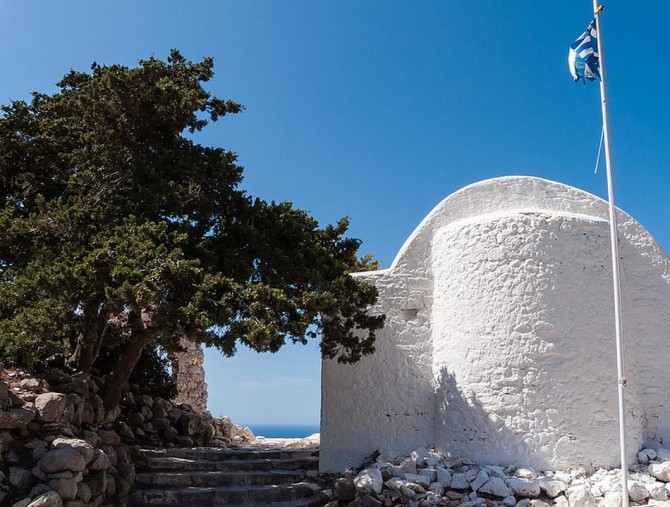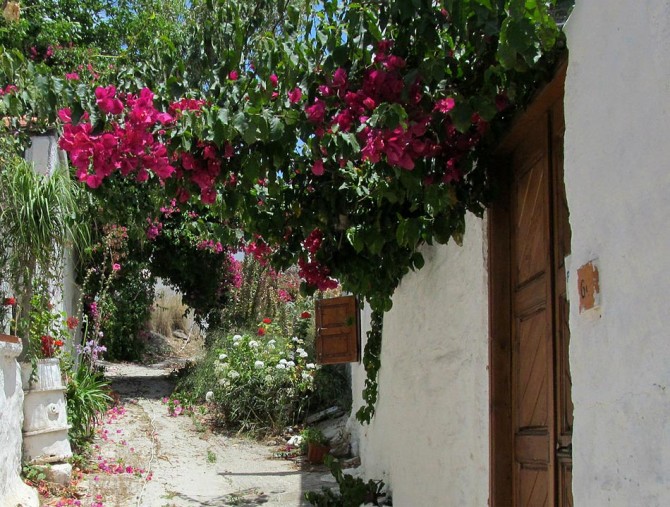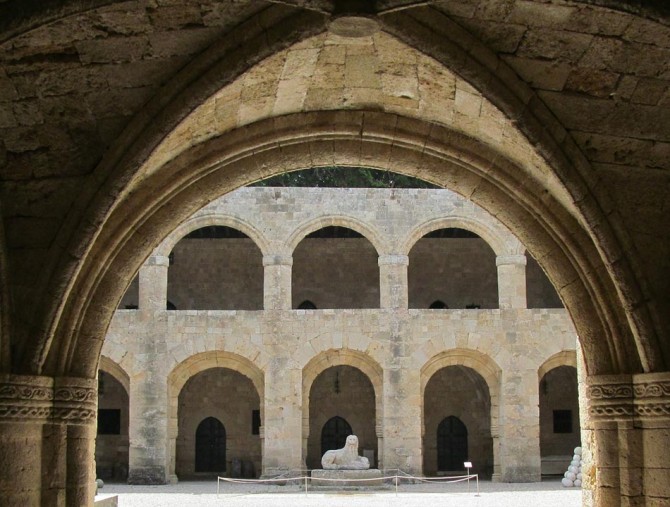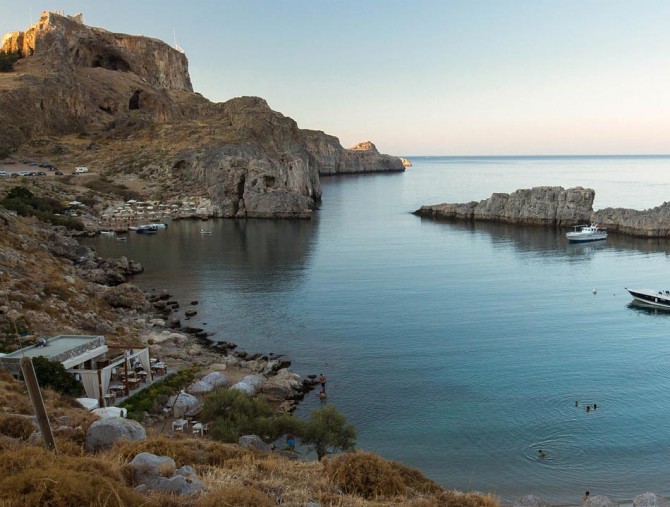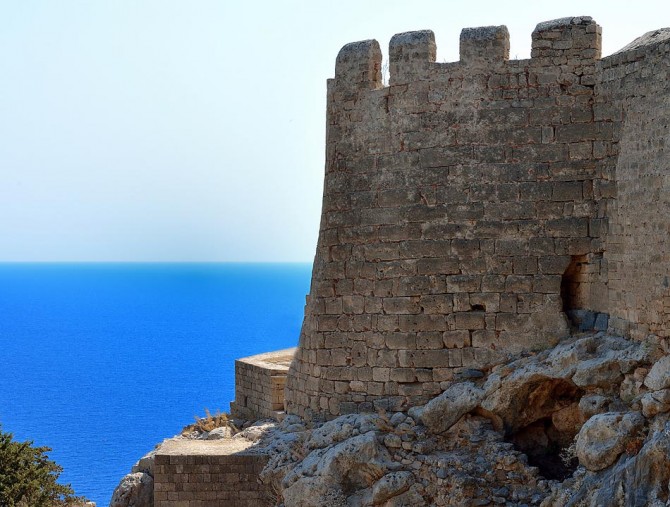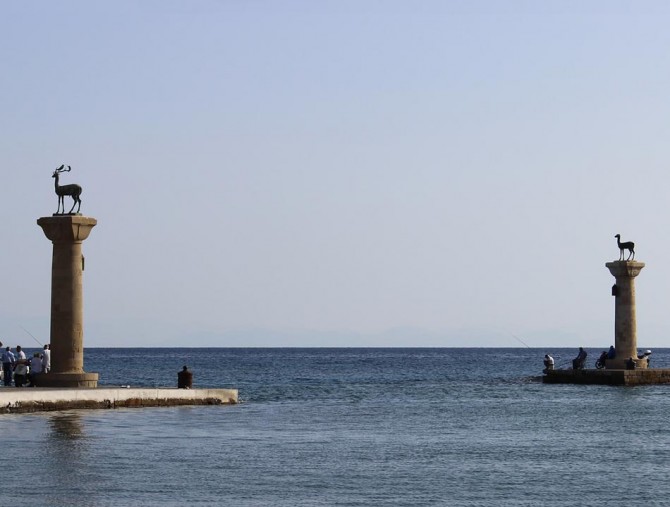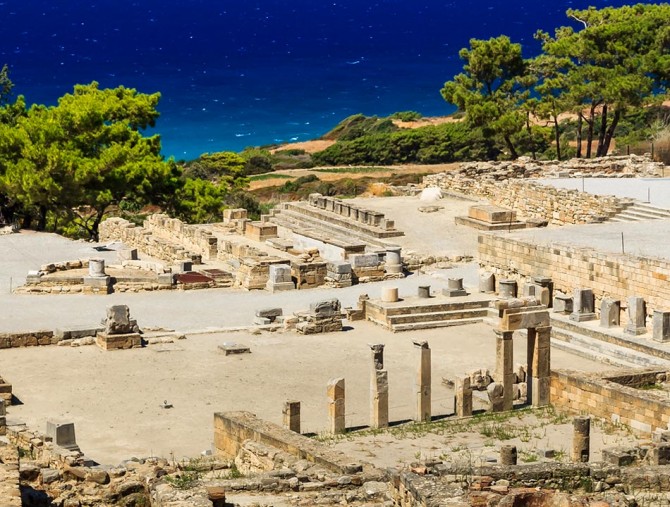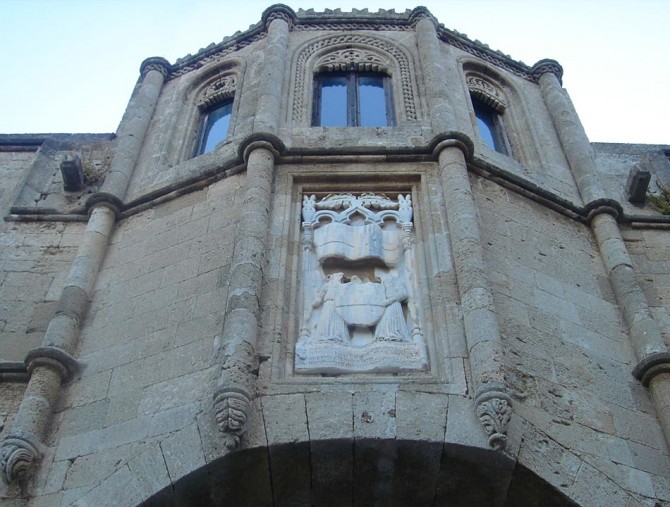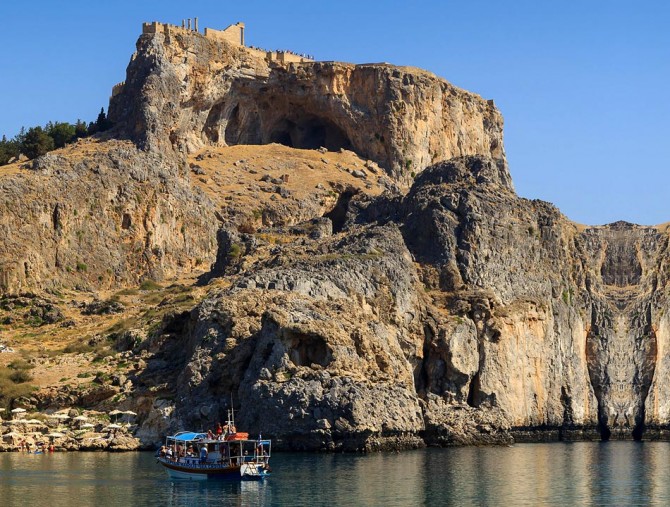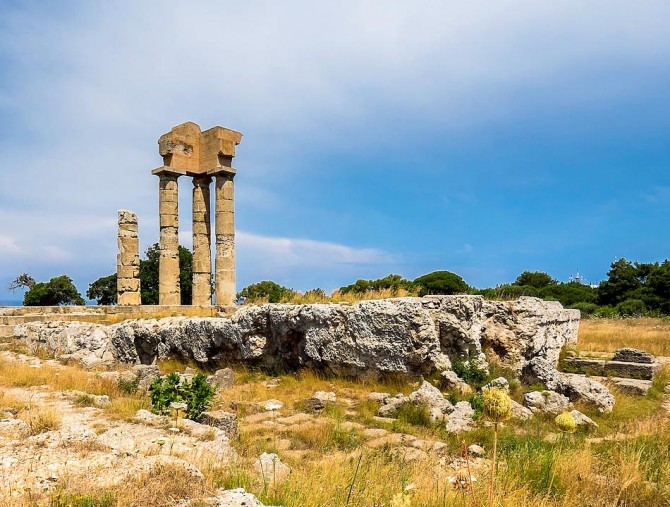Родос
Остров был населен еще с неолита. В XVI веке до н. э. он был под контролем минойского Крита, а в XV веке до н. э. микенцев с Пелопоннеса. В VIII веке до н. э. тут появляются города дорийских греков.
Родос был оккупирован персами, но освобождён после победы афинян в 478 году до н.э.. В 340 году до н.э. остров был оккупирован персами еще раз, после чего остров был освобождён в результате всегреческого похода на Восток во главе с Александром Македонским. В 403 году до н.э. столица острова была отстроена архитектором Гипподамом с регулярной планировкой.
Последующий период можно охарактеризовать как период наибольшего расцвета. В этот период здесь жили и работали ораторы Эсхин и Аполлоний Родосский, астрономы Гиппарх и Геминос. Одно из чудес древнего мира Коллос Родосский - гигантская статуя бога Гелиоса был построен в 292 году до н. э. при входе в городской порт. С сожалению эта статуя не выдержала сильнейшего землетрясения. Это произошло в 226 году до н.э..
В 164 году до н.э. Родос заключает союз с Римом, в первые годы нашей эры Апостол Павел приносит на остров христианство. В состав Византийской империи остров входил с 395 года.
Одна из главных достопримечательностей острова - Родосская крепость была построена рыцарями-госпитальерами, овладевшими островом в 1309 году. Эта крепость выдержала немало нападений: египтян в 1444 году и турок в 1408 году. В 1552 году после продолжительной осады госпитальеры были вынуждены оставить остров и направиться сначала на Сицилию, а потом на Мальту. Вместе с ними Родос покинула и часть греческого населения. С 1523 года остров вошел в состав османской империи. Жители Родоса приняли участие в освободительной борьбе Греции в начале XIX века, однако но военных действий на острове не велось из-за многочисленности турецкого населения и базирования объединённого турецко-египетско-алжирского флота.
В 1912 году после поражения турок в ходе итало-турецкой войны Родос переходит к Италии. Итальянцы контролируют остров до 1943 года. После выхода Италии из войны в 1943 году остров оккупировали германские войска.
Окончательно воссоединение с Грецией произошло лишь в 1948 году.
С островом связано также немало мифов.
Нимфа Родос, как сообщает в одном из своих од Пиндар, была дочерью Посейдона и Афродиты и возлюбленной Бога Гелиоса. Когда боги делили между собой землю, верный своему долгу Гелиос совершал вокруг неё свою ежедневную поездку. Поэтому во время дележа бог Солнца отсутствовал. Когда Гелиос вернулся, Зевсс, не желая оставить его обделенным, решил произвести дележ заново. Однако между тем Гелиос увидел, как из глубин моря поднимается большой прекрасный остров. Этот остров он и попросил для себя, решив, что земля его достойна, чтобы вступить там в брак с нимфой Родос.
На протяжении многих веков Родос являлся важным торговым портом Восточного Средиземноморья. Остров сыграл значительную роль в истории региона, и в период его расцвета особого развития достигли литература и искусство. Живопись, скульптура, поэзия, философия, астрономия, физика и география достигли здесь апогея. Вскоре после своего основания город Родос сосредоточил всю культурную жизнь острова, создав в то же время благоприятные условия для пребывания здесь деятелей культуры из других областей.
Из родосской живописи, к сожалению, не сохранилось никаких образцов. Однако письменные источники сообщают много сведений о творчестве художников на Родосе.
Значительно богаче знания о керамике. Этот вид искусства развивался на Родосе, начиная с микенской эпохи вплоть до наших дней, а образцы его можно видеть в Археологическом музее Родоса. В VII-VI вв. до н. э. родосская керамика переживает расцвет, являясь единственной способной конкурировать с коринфской. Характерными образцами этого времени являются сосуды с изображениями диких козлов, оленей и грифонов, чередующимися с гирляндами из анфемиев и цветов, а также фикелурского стиля с декором, составленным из изображений куропаток на центральном поясе между полосами цветочного орнамента.
Особого развития достигла на Родосе скульптура. Родосские мастера использовали не мрамор, а поролит, который покрывали штукатуркой. С V в. до н. э. на Родосе существовала самостоятельная школа скульптуры. В эллинистическую эпохушкола родосской скульптуры была одной из наиболее значительных в Греции и самой известной на востоке. В этот период на острове работало более 130 мастеров из 50 греческих городов. Родос был знаменит не только как место процветания изобразительного искусства, но и как родина многих творцов литературных произведений — таких, как Писандр из Камира (VI в. до н. э.) и поэт Клеобул из Линда (VI в. до н. э.), который был одним из семи мудрецов древности и тираном в родном городе.
На Родосе процветало также ораторское искусство, филологические науки, высокого уровня достигли география, физика, математика, астрономия и медицина.
На острове следует посетить Величественный Акрополь, античные руины которого гармонично переплетены со средневековыми стенами и зданиями крепости госпитальеров, доминирует над уютной деревенькой, слагаемой бело-коричневой архитектурой как вековых, так и более современных построек. Не менее интересны археологические раскопки Камирос - руины древнего города с его городской площадью, жилыми кварталами и системой водоснабжения V века до н. э., переносят в далекое прошлое эллинистического Родоса. Вблизи Колимбии находится самый древний в мире природный парк с остатками гидротехнических сооружений под названием Семь источников (Επτά Πηγές). И наконец главная достопримечательность Родоса - Родосская крепость. Она была резиденцией 19 великих магистров ордена госпитальеров, центром Коллакиума, квартала родосских рыцарей, а также последним прибежищем жителей в момент опасности. Построенная в XIV веке, она уцелела при землетрясениях и осадах, но была разрушена в 1856 году случайным взрывом. Дворец восстановили итальянцы в 1930-е годы для Муссолини и короля Виктора
Имануила III. Здесь хранятся мозаики с острова Кос, сюжеты которых дали названия залам, а также проходят выставки, посвящённые истории средневекового и античного Родоса.
Помимо культурных достопримечательностей не стоит забывать на Родосе и пляжи. В прошлом году 24 из них были отмечены Голубым флагом - сертификатом соответствия самым высоким стандартам. Лучшим среди лучших считается пляж Энтони Куинн. Он был так назван потому что именно здесь снимался фильм “Пушки Наварро” с Энтони Куинном в главной роли. Из-за своего подводного рельефа он считается раем для любителей подводного плаванья. Что касается рая для серферов - то таковым считается пляж Прассониси. Это название небольшого полуострова в южной части Родоса в 90 километрах от столицы. Пляж Фалираки считается наиболее хорошо организованным пляжем на острове - его длинна составляет 4 километра. Также хорош пляж Лардос в 65 километрах от города Родос.
И наконец - ночная жизнь острова считается весьма интенсивной и удовлетворит даже самые высокие запросы.
Как добраться до Родоса:
- по морю из порта Пирея
- по морю с других греческих островов
- по воздуху, Международный аэропорт Родоса “Диагорас” находится в 15 км от города Родос. Тел.+30 2241 08 87 00
Τекст: Александр Фролов
Rhodes
Imposing medieval monuments, the myth of the Colossus of Rhodes, the valley with the butterflies, the fabulous beaches and the incredible natural beauty are some of the reasons that bring Rhodes among the leading destinations worldwide. The largest island of the complex of Dodecanese is strategically located at the point where the Europe, the Asia and the Africa meet.
In the antiquity, Rhodes hosted one of the Seven Wonders of the Ancient World, the famous brazen Colossus. After their victorious battle against the Macedonian general Dimitrios Poliorketes (Besieger) in 305 BC, the citizens of the island decided to honor the God Helios (Sun), whom they believed that was responsible for their victory, constructing a majestic statue that mankind would not have seen until then. The sculptor Haris from Lindos needed more than 12 years to complete his magnificent work, between 292 and 280 BC. The legend has it the Colossus was higher than 32 meters and stood somewhere in the harbor of the ancient city, probably at its entrance, with the ships passing under its open legs. A devastating earthquake in 224 BC threw the statue down. As the citizens believed that this was a divine sign, they never restored Colossus. Centuries later, around 653 AD, when the Arabs raided the island, they sold the pieces of the Colossus to Arab
traders, who carried them to the Syrian markets to sell them as precious metal. Today what remains from this amazing statue is only its legend.
The ancient monuments in Rhodes are quite many. In the Hill Monte Smith, above the city of Rhodes, is where you can visit the Upper Acropolis of the ancient city and also a significant archaeological site, including a small marble outdoor theater, which today hosts musical concerts as in antiquity, and the ancient stadium of Diagoras, where the Alion Games were held, the great feast of the ancient Rhodes in honor of the god Helios. Needless to say that apart from the archaeological interest, the Hill worth a visit also for the breathtaking view, especially in the evening, during the sunset. The entrance is free.
In the southeastern side of the island, around 55 km from the city of Rhodes, there is Lindos, a quaint and beautiful village which has declared as preserved, due to its narrow cobbled streets and the whitewashed small houses that are adorned with floors paved with pebbles and painted ceilings. The major sights of Lindos are the imposing captain houses, built between 16th and 18th century AD, the church Panagia of Lindos in the village center, with its amazing 15th century frescoes, the “tomb of Kleovoulos,” a funerary monument of the 6th century BC, the “Archokrateion”, a tomb of the genus Archokratidon in the Hellenistic era and the Acropolis of Lindos, which is perched on a high hill. In the Acropolis you will see the Sanctuary of Athena Lindia of the 4th century BC, the Propylaea, the great Hellenistic Stoa, the Byzantine church of St. John and the Headquarters of the Knightly Era. What you will never forget is the relief trireme of the 2nd
BC century which is carved at the base of the rock. The entrance is 6 euros.
The ancient Kameiros is located 30 km away from the city of Rhodes, also on southwest. Along with Lindos and Ialyssos, Kameiros was one of the three great ancient cities of the island. In the archaeological site, which was discovered in 1929, departments of houses and buildings, the ancient Agora, the Doric temple and some arches, the Hellenistic Mosque, the central street of the ancient city, the ruins of the aqueduct and traces of the temple of Athena are still preserved today. The entrance is 4 euros. Near the archaeological site, there is the Monastery of the Virgin Mary, which is built at the same position where the temple of Athena stood in the 3rd century BC.
In the beautiful city of Rhodes there is another city within the city: The girded Medieval city is one of the biggest attractions of the island and the main reason why Rhodes is also called “The island of the knights”. It was built during the Knightly Era (1309-1522) according to the Western European Late Gothic style. Among the impressive monuments you can visit here there are the Grand Master’s Palace, which houses the Byzantine Collection of the island, the Hospital of the Knights of the 14th century (at Simi square), the Hospital of the Knights of the 15th century (at Alexander Square) which also serves as National Archaeological Museum, the Knights Street, which is the most well preserved street of its kind in Europe, the Municipal Art Gallery at Simi Square, the Argyrokastrou Square with the early Christian Baptistery, the old Arsenal of the Knights which now houses the Museum of Folk Art , the ruins of the Temple of Aphrodite, the Mosque of
Suleiman and the Palace of Kastellania, which today houses the Municipal Library. The church Panagia of the Castle of the 11th AD century is the largest and oldest surviving church in the medieval city and also worth a visit. The Medieval City of Rhodes is also listed among the hot spots of the island, since many bars and clubs are located there.
The natural beauties of Rhodes are countless. The Valley of the Butterflies, to begin with, is a dreamy natural park, with specially adapted paths and wooden bridges between the incredible beauty vegetation, ponds with water lilies, small waterfalls and crystal clear waters. It is famous as the habitat of the butterfly Panaxia Quadripunctaria, which appears in the period from mid June to mid September. It is located twenty-five km from the city of Rhodes, near the village Kalamonas. At the entrance of the park there is also the very interesting Museum of Natural History of Rhodes. The entrance in the Valley of the Butterflies is 5 euros.
The Park Rodiniou, 3 km from the city of Rhodes, is the most ancient park of the world. It is distinguished by its dense and diverse vegetation and the peacocks that walk freely in this heavenly made place. It is located in the Rhodes-Lindos-Rodini Avenue and the entrance is free. The entrance is free also in the Spring Fasouli, which is located in the village Psinthos. The nature thrives around the torrent, while there is also a small artificial pond which hosts the protected, unique in the world, fish Gizani. The Epta Piges (Seven Springs), 19 km from the city of Rhodes, is another gorgeous natural park you can visit for free in the island. The towering pines and plane trees hide a small pond with seven springs, full of ducks, geese and peacocks.
If the ancient monuments and the natural attractions are not enough for you to visit Rhodes, then you should also consider the magical beaches. Rhodes was rewarded with 24 “Blue Flags” in 2014, which means that the beaches of the island meet the highest standards of environmental quality. The best among the best are: The beach Anthony Quinn, which is ideal for scuba diving because of its underwater topography. It became notorious by the movie “The Guns of Navarone’ which was filmed there, starring the famous actor Anthony Quinn. The Prassonisi is the surfers’ paradise. Located in the south part of the island, 90 km from the city of Rhodes, is a small peninsula in the summer and an islet in the winter. The Faliraki is one of the most organized beaches of the island, and its length is 4 km. The Lardos, 65 km from the city of Rhodes, is the only beach of the island awarded with the European “Blue Flag”. And those are only a few of the many
fabulous beaches of Rhodes.
The excellent hotel facilities and the intense nightlife are also listed among the advantages of this extraordinary island.
How to get there: By ship from Piraeus port. Rhodes is also linked by ship with other Greek islands. By air: Rhodes International Airport “Diagoras”, Paradisi village, 15 km westwards the city of Rhodes, tel.: +30 2241 08 87 00.
Τext: Marilou Pantazi

